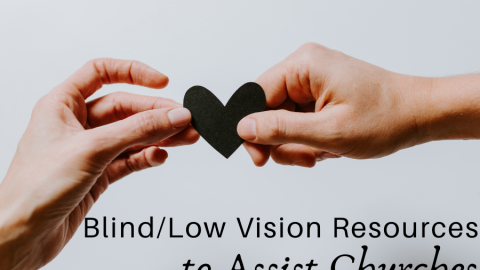Best Practices for Accessible Communication in Churches
0 comments
656 views

This article is part of the series: How to Create Welcoming Spaces for People Who Are Blind or Have Low Vision. We have collaborated with our friends at the RCA on their online platform, Faithward.
---------------------------------
Every church should be a place where everybody belongs and everybody serves. This is the goal of Disability Concerns, both in the Christian Reformed Church in North America (CRCNA) and the Reformed Church in America (RCA). Often, people with disabilities are inadvertently overlooked and not able to participate fully in the life of the church. To change that narrative, consider with your church some of these ways that you can better welcome and include people who are blind or who have low vision.
Choose curricula with material that is available in alternative formats, or adapt curricula as needed so all can participate.
Provide the same information to congregants who are sighted, blind, or have low vision, in the form of electronic and large-print documents. Ask the members of your congregation who are blind or have low vision what format works best for them. Information that should be shared in various formats include the following:
When creating electronic documents,
ask members of your congregation who are blind or have low vision which formats they prefer (e.g., Microsoft Word).
make documents available at least 24 hours in advance to allow time for congregants to gather all information related to the service. Sharing options include emailing the documents, or posting a QR code near the worship space for congregants to scan and access all documents. (Search “QR code” for how to create a QR code that links to an online folder of documents.)
Read these web content accessibility guidelines to learn how to make your church’s website more accessible.
When creating large-print documents,
During worship services,
For projection,
consider audio-describing any videos.
Audio description is a narrative audio track that describes all essential visual information that is necessary to understanding the story and purpose of the video.
Watch the “Why Describe?” video from Rooted in Rights to learn the importance of and how to prepare an audio description.
For an example of an audio-described video, check out this “Like the Mic” video from Rooted in Rights.
If a full audio description is not feasible, encourage the reading aloud of any text appearing in a video.
If any of these alternate formats and accommodations are not possible in your setting, talk with members of your congregation who would benefit from these accommodations and find a workable plan for ensuring that everyone is included in worship.
Disability Concerns, Church Admin & Finance
Disability Concerns, Church Admin & Finance
Disability Concerns, Training and Education
Disability Concerns
Connect to The Network and add your own question, blog, resource, or job.
Add Your Post
Let's Discuss
We love your comments! Thank you for helping us uphold the Community Guidelines to make this an encouraging and respectful community for everyone.